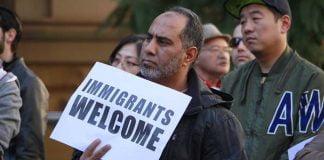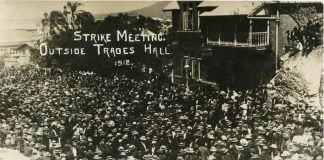In 1972 migrant workers showed that they can be among the most determined in fighting for workers’ rights. There are lessons for us today, argues Tom Orsag
The Ford Broadmeadows strike was one of the most explosive and militant disputes in the history of the Australian union movement. And at its heart were migrant workers.
In the context of scaremongering about “foreign workers” on 457 visas as some kind of threat to jobs, it is an important reminder of the need for unity with migrant workers.
On 13 June 1973, 1500 strikers at the Ford factory in Broadmeadows, Melbourne, fought a six-hour battle with the police to close the plant. They were fighting to keep their four week old strike alive.
Such was their anger that, at one stage, the workers pushed over a 30 metre section of brick fence and used the bricks to smash the windows of the factory.
Later the Furnishing Trades Union banned any repairs to the smashed windows until the dispute was settled.
They sprayed fire-hoses into offices. Factory signs were pushed over.
Stones and rocks were hurled. They did anything they could think of to express their rage at the company.
The picketers stopped a fruit truck at a gate and hurled carrots, oranges and tomatoes at the 100 police called in by Ford. The police tried to disperse their picket line by riding horses into them.
But the strikers said they would not go back to work or leave the area until the rest of the workers inside joined them outside, on strike.
Their sheer militancy turned the tide. Throughout the day, the workers still inside walked out. The company was forced to close the gates and the four-week-old strike gained new strength.
About $85,000 worth damage in today’s terms had been done to the building.
Yet the police didn’t arrest a single striker that day.
Exploitation
The explosion of anger at Ford stemmed from the intense hatred workers had for Ford management. Around 75 per cent of the 6000 workers at Ford were migrants, most of them on the assembly line. Like generations of migrant workers since, they faced increased exploitation compared to the majority of Australian-born workers.
Management used language difficulties to fob off complaints. Work contracts and safety signs were all in English.
One worker, Sol Marks, said, “I’d never worked in a place so bad, particularly for migrant workers… there was degradation, humiliation, brutality.”
Assembly line workers had to wait up an hour to be relieved by a workmate so that they could go to the toilet. Another worker said, “It gets so that you can spend two hours of your day just thinking about getting to the toilet.”
Some of the key demands of the strike were for an afternoon tea-break and slowing down of the production line. The worker quoted above said, “When you work on the line it dominates your life. The day is an endless procession of cars moving down the line.
“You simply can’t afford to get behind and, if you do anything wrong, you cop the abuse of a supervisor or foreman.”
If they were late for work by only a minute, workers at Ford had to pay a $2 fine. This was a whole hour’s pay!
As Lokman Kalehsi, a Turkish strike committee member put it, “Because they can’t speak much English they work under inhuman conditions—companies are absorbing migrant blood and making millions.”
But the strike showed that migrant workers were also more than capable of fighting for their rights.
The 1970s were a period when strikes were breaking out all over the country. The economy was booming and the bosses were making massive profits.
This meant that even a short strike could cost them millions in lost production. So workers were confident of their ability to win concessions.
All sorts of workers went on strike, from airline workers, ambulance drivers, garbos and BHP steelworkers. Even the weather forecasters struck! It was a very different atmosphere from today.
Such was the level of militancy amongst workers that when Gough Whitlam’s Minister for Labour, Clyde Cameron, was asked why the police didn’t arrest any of the strikers at Ford, he replied, “The match that can bring about the explosion could be police intervention.”
The dispute
In May, the union officials in the car industry had planned a campaign to win pay rises for their members. But their plan was completely bureaucratic.
They decided to campaign at General Motors Holden (GMH) first and told the Ford workers they had to wait until the claim was won at GMH.
On 18 May, Ford workers took the issue out of the hands of their officials and voted to go an immediate indefinite strike, unlike the official plan for short “guerrilla” stoppages.
The union officials had proposed asking for a modest $6 a week pay rise over ten months. Ford workers threw that out, demanding $17 a week.
After four weeks on strike, Ford offered $4 a week and minor concessions in the form of improved work conditions. Ford had lost $27 million in production to this point.
At a mass meeting at Broadmeadows Town Hall on 11 June, the officials, including the prominent Communist Party leader of the Metalworkers Union, Laurie Carmichael, recommended a return to work.
The vote was close. Many strikers did not understand English well and had not understood what was being voted on. Carmichael ruled the return to work was carried.
A large minority did not want to return to work with so few concessions from Ford. Many of the workers were Greek, Italian, Turkish and Yugoslav and had experience in struggle in their home countries.
They were so enraged at the officials’ manoeuvring that they rushed the stage when the officials announced the vote was to return to work. In the scuffle, they ripped Carmichael’s coat. He had to be ushered from the hall for his own safety.
The shop stewards advised Carmichael and the other officials not to turn up at Ford on 13 June, the day of the expected return to work. The militant minority would have picket lines, where the officials would not be welcome.
After the mass meeting, Ford sent telegrams to 1000 workers instructing them to turn up to start at 7am, rather than the usual time of 7.30am.
When the militants turned up to picket the plant at 7.30am, they were enraged to learn that 1000 workers were already inside.
It was then that they began their spectacular battle to close the plant.
After a couple of hours of stone throwing, one shop steward told the crowd not to use violence or to stand in the middle of the car park.
At this suggestion, the picketers jeered and rocks flew over his head, smashing the canteen windows. The crowd jeered even louder when several workers presented a posy of flowers to one of the Ford security guards.
By noon, the workers inside the factory had begun to walk out to join the picket line. The factory then emptied steadily and the strike was back on. Migrant and local workers united on the picket line. By 4pm Ford closed the plant.
After this explosion of militancy, the union officials realised that they had to change tack to regain some credibility with the workers in the car industry.
The union officials called another Ford mass meeting for 15 June and argued for an indefinite strike.
Laurie Carmichael ate humble pie and told them, “I say to you sincerely that I made a mistake and you have taught me a lesson.” The mass meeting voted to continue the strike.
Finally on 23 July, the strike ended after gaining an improved offer from Ford on both pay and conditions.
Some workers wanted to hold out for more but the officials split them up into separate meetings for the different nationalities and managed to win a majority for going back to work.
Victory
The Ford workers had shown a militancy that came from the confidence of the working class in that era and the super-exploitation experienced by migrant workers.
They beat their multinational employer, despite the opposition of the police on the picket line and the foot dragging of their own officials at mass meetings.
Ford agreed to slow the assembly line, hire more workers, hire women, increase the number of toilet breaks, repair leaking roofs and increase wages over and above their original offer.
As one worker put it, “We showed the company that we were not slaves… they started being very afraid of the workers and the union. They speak to us workers with respect. They don’t address us like you would a dog, as they used to.”
In the aftermath of the dispute the ruling class realised it needed to do more to incorporate migrants into the system.
The exploitation of the new migrant workers compounded their alienation from the institutions of a society that was only just abandoning the White Australia Policy.
The government adopted the new policy of multiculturalism, and set up an array of ethnic affairs commissions, enquiries, radio stations, new welfare programs, anti-discrimination legislation and the like, with the aim of drawing in middle-class immigrant activists.
But the strike showed that migrant workers were willing to fight for their rights.
The strike at Ford created a powerful group of union delegates who were to lead other successful strikes in the years ahead.
Migrant workers have been among the best fighters the union movement here has produced. They are not a threat to jobs—they are the allies of every worker that wants to fight for wages, to defend jobs and to rebuild the unions.





